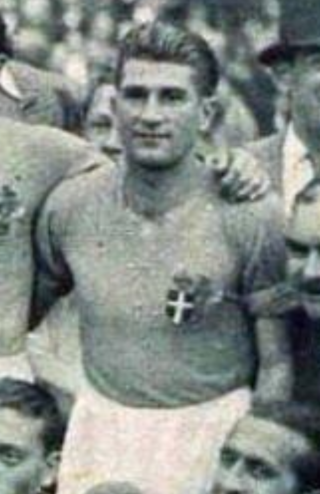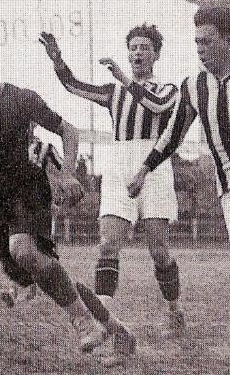
Raimundo Bibiani "Mumo" Orsi was an Italian Argentine footballer who played as a winger or as a forward. At the international level he represented both Argentina and Italy, winning the 1927 Copa América and the silver medal at the 1928 Summer Olympics in Amsterdam, Netherlands, with Argentina, as well as two editions of the Central European International Cup and the 1934 FIFA World Cup, with Italy.

Gianpiero Combi was an Italian footballer who played as a goalkeeper. He spent his entire club career at Juventus, where he won five Italian League titles. At international level, he won the 1934 World Cup with the Italy national team, as well as two Central European International Cups, and an Olympic bronze medal in 1928.

Luis Felipe Monti was an Italian Argentine footballer who played as a midfielder and an Olympian. Monti has the distinction of having played in two FIFA World Cup final matches with two different national teams. He played the first of these finals with his native Argentina in 1930, which was lost to Uruguay; and the second with Italy as one of their Oriundi in 1934, thanks to his Romagnol descent. This second time Monti was on the winning side in a 2–1 victory over Czechoslovakia.

Virginio "Viri" Rosetta was an Italian footballer who played as a defender. A hard-working player, he was known for his organisational skills, and for his ability to read the game and anticipate other players; he was also known to be a very precise passer of the ball, and an elegant full-back with good technique and a powerful shot, who was capable of starting plays from the back-line.

Angelo Schiavio was an Italian footballer who played as a forward. Schiavio spent his entire career with Bologna, the club of the city where he was born and died; he won four league titles with the club, and is the team's all-time highest goalscorer. He won the 1934 FIFA World Cup with Italy, finishing as the tournament's second highest goalscorer; winning the 1927–30 Central European International Cup & 1933–35 Central European International Cup and he also won a bronze medal with Italy at the 1928 Summer Olympics. Following his retirement, he later also managed both Bologna and the Italy national side.

Luigi Colausig, known as Gino Colaussi, was an Italian footballer who played as a striker. He was the first player to score multiple goals in a World Cup final.

Amedeo Biavati was an Italian footballer, who was born in Bologna. He was usually deployed as forward or as a midfielder on the wing. A very fast and creative player, with an eye for goal, precise crossing, and excellent technical ability and dribbling skills, Biavati is regarded as one of the greatest Italian players and wingers of all time, and is largely remembered for popularising the use of notable skills and feints in Italian football, in particular the step over.

Eraldo Monzeglio was an Italian association football coach and player, who played as a defender, in the position of full-back. Monzeglio had a highly successful career as a footballer, although he also later attracted controversy due to his close relationship with the Italian fascist dictator Benito Mussolini. At club level, he played for Casale, Bologna, and Roma, winning the Serie A title and two editions of the Mitropa Cup with Bologna. At international level, he also had success representing the Italy national football team, and was a member of the Italian teams that won consecutive FIFA World Cup titles in 1934 and 1938, being named to the tournament's All-star Team in 1934; he also won two editions of the Central European International Cup with Italy. Along with Giuseppe Meazza and Giovanni Ferrari, he is one of only three Italian players to have won two World Cups. Following his retirement as a player, he worked as a coach for Italian clubs Como, Pro Sesto, Napoli, Sampdoria, and Juventus, as well as Swiss club Chiasso. He was posthumously inducted into the Italian Football Hall of Fame in 2013.

Luigi Allemandi was an Italian footballer who played as a defender, usually as a left back. He was a member of the Italy national team which won the 1934 World Cup.

Luigi Bertolini was an Italian footballer who played as a midfielder.

Enrique Guaita, also known as Enrico Guaita, was an Italian Argentine footballer who played for both Argentina and Italy as a forward. He helped win the 1933–35 Central European International Cup & the World Cup in 1934 with Italy.

Mario Pizziolo was an Italian football player and manager, who played as a central or defensive midfielder.

Carlo Ceresoli was an Italian football goalkeeper.
Ernesto Alberto Mascheroni Castiglioni was a footballer from Uruguay. Born in Montevideo, Ernesto was a defender. He played as a left-back.

Pietro Serantoni was an Italian football midfielder and manager.
Amphilóquio Guarisi Marques was an Italian Brazilian footballer who played as a forward. In Brazil he was known as Filó and in Italy as Anfilogino Guarisi. Throughout his career he played football in both Brazil and Italy, representing both nations at the international level, and was a member of the Italian team that won the 1934 FIFA World Cup.

Roberto Porta was a Uruguayan–Italian footballer who played as a forward.
Alfredo Pitto was an Italian footballer who played as a midfielder. He competed in the 1928 Summer Olympics, winning a bronze medal in the tournament.
Juan Ricardo Faccio Porta was a Uruguayan football player and manager.
Francisco Fedullo, also spelt as Francesco, was a footballer who played international football for both Uruguay and Italy. He played as a midfielder or as a defender for Sud América and Bologna.















